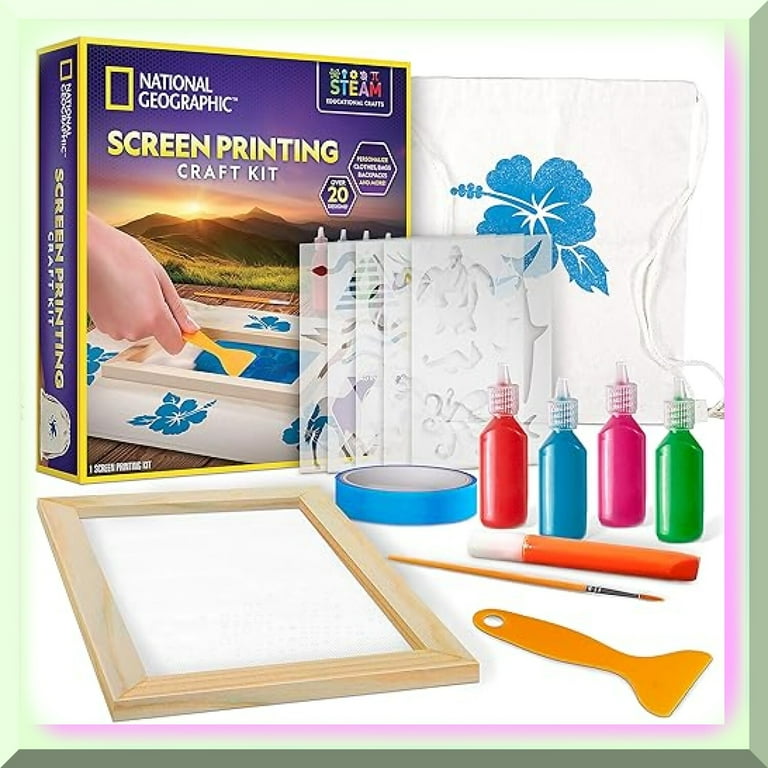Artistic Silk Screen Printing for Limited Edition Prints
Display Printing Uncovered: Everything You Need to Know Regarding Tee Shirt and Garment Printing Strategies
Display printing is an interesting technique that combines art with method, providing countless possibilities for creativity. Prepared to check out the necessary components that make screen publishing an art type?
The Basics of Screen Printing: Exactly How It Works
When you plunge right into screen printing, you'll uncover it's both an art and a science. At its core, display printing involves producing a pattern, or screen, that allows ink to pass with just in details locations.
Next, you'll mix your inks and prepare your printing surface. Position the screen over the textile, then use a squeegee to push ink through the display onto the garment. This procedure needs accuracy, as you want clear, vibrant prints. After printing, you'll heal the ink with heat, guaranteeing it abides by the fabric and lasts via laundries. Each step is necessary, and mastering them will certainly raise your screen printing skills, transforming easy garments right into distinct, expressive items.
Kinds Of Display Printing Techniques
As soon as you understand the fundamentals of display printing, it's time to check out the various techniques that can boost your designs. One prominent approach is conventional display printing, where ink is pushed through a stenciled display. This technique is great for vibrant, vivid colors. Then there's water-based ink printing, which offers a softer feel and is eco-friendly, however it requires a various approach to curing.
If you're intending for fine information, consider discharge printing. This technique gets rid of color from the textile, leaving a soft, vintage look. An additional choice is plastisol printing, recognized for its toughness and vibrant shades, making it a preferred for numerous brand names. Experiment with halftone printing to develop slope effects and intricate styles. Each method has its special appeal, so don't wait to try them out to discover what matches your style best!
Necessary Equipment for Screen Printing
To accomplish magnificent results in screen printing, having the right tools is fundamental. You'll require a durable display printing frame, which holds the mesh that transfers your design onto the garment. Next, invest in high-quality squeegees; these are crucial for applying ink evenly throughout the screen.
Picking the Right Inks and Products
When choosing inks and products for display printing, you need to think about the sort of ink that works ideal for your task. Think of textile compatibility to guarantee your designs look last and excellent long. Discover eco-friendly ink choices to make your printing process more sustainable.
Sorts Of Screen Inks
Picking the appropriate screen ink is essential for achieving vivid, long lasting prints that satisfy your project's demands. There are a number of sorts of display inks to take a look at. Plastisol ink is popular for its adaptability and convenience of usage, giving exceptional shade opacity on dark textiles. Water-based ink, on the various other hand, supplies a softer feel and is eco-friendly, making it optimal for those seeking to decrease their ecological impact. Discharge inks get rid of color from the fabric, leading to a soft, classic look yet need specific handling. Ultimately, specialty inks, such as glow-in-the-dark or metal, can add unique results to your layouts. Review your project needs and choose the ink that straightens finest with your preferred result.

Fabric Compatibility Factors To Consider
Understanding fabric compatibility is important for achieving premium screen prints, particularly since various products react uniquely to various inks. When selecting inks, think about the textile type-- cotton, polyester, or blends. For cotton, water-based inks work well, supplying soft qualities and breathability. Polyester, on the other hand, frequently calls for plastisol inks for better adhesion and vivid shades. If you're publishing on blends, you might need to utilize a combination of both kinds. Always evaluate your inks on sample textile to ensure they stick effectively and preserve shade integrity. Additionally, bear in mind that material weight and structure can affect the final outcome, so picking the best ink and material combo is essential for your job's success.
Eco-Friendly Ink Options
Green inks are ending up being a preferred choice for screen printers who intend to lessen their ecological influence while maintaining top quality. When selecting inks, consider water-based inks, which are less hazardous and less complicated to cleanse up compared to typical solvents. These inks bond well with textiles, supplying vibrant results without hazardous chemicals. You might likewise discover eco-solvent inks that make use of fewer volatile natural compounds (VOCs), making them a more secure option for both your health and wellness and the earth.
Additionally, try to find inks made from renewable energies, such as soy or vegetable-based alternatives. By selecting the appropriate inks and materials, you'll not just develop sensational designs but additionally contribute to an extra sustainable printing process. Make the button, and your prints will certainly reflect your commitment to the environment!
Preparing Your Layout for Screen Printing

File Layout Requirements
To ensure your design looks sharp and dynamic on textile, you'll require to pay very close attention to submit style requirements for screen printing. Begin with vector documents like AI or EPS, as they can be scaled without losing high quality. If you use raster photos, go with high-resolution data, such as TIFF or PNG, ideally at 300 DPI. Stay clear of making use of JPEGs, as they can lose quality when resized. Additionally, make certain your design has a transparent background to stop unwanted white sides on your prints. Lastly, maintain shade settings in mind; CMYK is common find more info for screen printing, so transform your RGB makes accordingly. By following these guidelines, you'll establish your artwork up for a successful print.
Shade Separation Techniques
Color splitting up is a necessary action in preparing your layout for display printing, and understanding it can greatly enhance your print high quality. You'll need to break your style into individual shades, as each shade calls for a different display during printing. This accuracy not just ensures precise color representation but likewise simplifies the printing process.
Resolution and Size
Achieving the best outcomes in screen printing begins with assuring your style has the right resolution and size. Preferably, your art work needs to go to least 300 DPI (dots per inch) for sharp, clear prints. Your final product could look less than professional and pixelated. if you make use of lower resolution.
When it concerns dimension, consider the measurements of your print location. Design your art work to match the last print size, ideally creating it in the actual dimensions you'll be printing. In this manner, you'll prevent any unexpected scaling concerns.
Constantly examine your layout in both vector and raster formats. Vector graphics can be scaled without shedding high quality, making them ideal for display printing. Preparing appropriately will assure your layout looks incredible on every garment!
Step-by-Step Screen Printing Refine
Screen printing is a vibrant procedure that enables you to create lively designs on numerous surfaces. To begin, you'll require a screen, solution, and your picked ink. Prepare your display by cleansing it thoroughly. Next, apply the emulsion equally and let it dry in a dark area. When completely dry, reveal your screen to light with your style put on it, which will certainly harden the emulsion where the light hits, developing a pattern - screen printing kit.
Put ink onto the display and use a squeegee to press the ink via the pattern onto the fabric. Lift the screen meticulously and allow the print completely dry. You have actually effectively display printed your style.
Tips for Successful Screen Printing Projects
While you're diving into your screen printing projects, bear in mind that look at this website preparation is essential to success. Start by collecting all your products-- inks, garments, squeegees, and displays. A tidy office assists stop undesirable errors, so clean up before you start.
Next, validate your art work is high-resolution and correctly sized for your garment. Test your screen for correct direct exposure and tidy it thoroughly to stay clear of smudges. When mixing your inks, comply with the manufacturer's guidelines to accomplish the appropriate consistency.
Throughout printing, apply also stress with your squeegee for regular outcomes. Do not hurry; take your time to validate each print satisfies your standards. After printing, allow your garments dry entirely before managing or packaging them.
Last but not least, always maintain a sample of your job for future recommendation. In this manner, you can assess your progress and boost your techniques gradually. Pleased printing!

Regularly Asked Concerns
How much time Does It Take to Establish a Screen Printing Task?
Establishing a display printing job usually takes about 30 minutes to an hour. You'll prepare the screens, mix inks, and change journalism. The time varies based on complexity and experience, so stay arranged!
Can I Publish on Different Material Types Using the Same Technique?
Yes, you can print on different material types using the same technique, however you'll need to adjust your inks and settings. Some materials absorb ink in a different way, so trying out guarantees the best outcomes for every material.
What Are Usual Mistakes to Stay Clear Of in Screen Printing?
When display printing, prevent common errors like making use of the wrong ink, overlooking proper exposure times, or missing pre-press checks. Always test your configuration and preserve tidy displays to guarantee quality outcomes each time.
How Can I Appropriately Tidy and Preserve My Screen Printing Equipment?
To correctly clean and preserve your display printing devices, you must on a regular basis clean displays with suitable solvents, examine mops for wear, and ensure all devices are saved dust-free and completely dry. Consistency prevents expensive repair work and enhances performance.
Is Display Printing Eco Friendly Compared to Various Other Methods?
Display printing can be more ecologically pleasant than other methods, specifically if you make use of eco-conscious products and water-based inks. By selecting sustainable supplies and methods, you lower waste and decrease your influence on the earth.
Screen Printing Uncovered: Whatever You Need to Know Regarding Tee Shirt and Garment Printing Techniques
At its core, display printing includes producing a pattern, or display, that permits visit this page ink to pass with only in particular areas. Placement the screen over the textile, then utilize a squeegee to push ink with the screen onto the garment. One popular approach is typical display printing, where ink is pushed with a stenciled screen.When picking inks and products for screen printing, you require to take right into account the type of ink that works finest for your project.